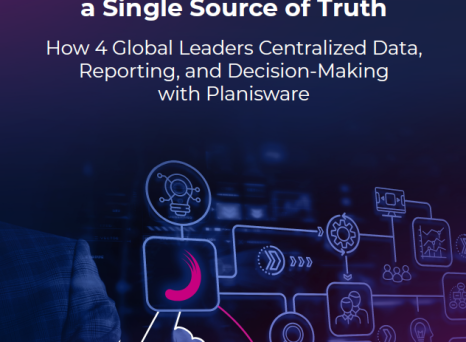For decades, project decisions were made based on experience, intuition, or top-down directives. While these methods can offer value, they don’t always deliver the speed, accuracy, or accountability required in today’s business landscape.
That’s where data-driven decision making comes in.
By using real-time project data, PMOs and portfolio leaders can make smarter, faster choices backed by reliable evidence, not assumptions. And that’s the case across initiatives: whether it’s flagging risks early, prioritizing the most high-value ideas, or making resource tradeoffs, a data-led approach improves project success and keeps teams focused on what matters most.
In fact, nearly 75% of companies agree that data transparency improves business performance and 73% of project professionals say it’s key to project delivery. But making the switch to a data-based approach isn’t always easy. It means rethinking tools, processes, and culture.
Still, for PMOs, the benefits largely outweigh the effort: with strategic investment in data platforms and practices, they can get better results, fewer surprises, and decisions that don’t just tick a box but actually build stakeholder trust.
What is data-driven decision making in project management?
In the context of project management, “data” is more than just spreadsheets or financial reports. It encompasses a broad spectrum of operational and strategic insights, from progress metrics and capacity dashboards to team sentiment and risk trends.
A truly data-driven PMO draws from various sources, including:
- Historical data: Past project performance, budget trends, time-to-completion metrics
- Real-time operational data: Task status, resource workloads, issue tracking
- Predictive analytics: Forecasts based on machine learning, AI, or trend analysis
- Qualitative feedback: Team sentiment, client satisfaction, stakeholder alignment
Bringing all these together provides a 360-degree view of both project health and organizational capacity, helping PMOs answer critical questions like:
- Are we investing in the right projects?
- Can we actually deliver with the resources we have?
- Where are we most vulnerable to risk?
5 practical ways to use data in project decision-making
A statistical or data-led approach to project management isn’t just about dashboards (but they can’t hurt!). From prioritizing portfolios to managing risks, there are many practical ways statistics can elevate project decision-making and drive better outcomes, including:
- Prioritization: Weighted scoring models help PMOs assess potential projects based on ROI, strategic alignment, resource impact, and risk. This leads to better portfolio balance and avoids spreading teams too thin.
- Resource planning: Predictive data shows where shortages or bottlenecks may happen, helping you forecast future demand and identify resource shortfalls before they impact delivery.
- Budget control: Real-time financial dashboards reduce the risk of overspending and enable faster corrective actions.
- Issue resolution: Early warning systems based on project KPIs allow project managers to flag deviations quickly and adjust timelines, scope, or staffing as needed.
- Stakeholder reporting: Live, interactive dashboards keep executives informed without constant meetings, building trust through transparency.
But, of course, data isn’t just about the numbers. Beyond operational improvements, it transforms the way teams work, hold each other accountable, and continually (and confidently) align around shared goals.
Take as an example global technology firm CAE, which overhauled its project management practices by centralizing data flow, resulting in major gains in not just delivery speed and budget management but also stakeholder trust and engagement.
How to get started: 5 best practices for building a reliable data foundation
Adopting a data-based approach to decision-making can significantly enhance project accuracy, foresight, and efficiency—but success depends on how it’s implemented. In other words: building a trustworthy foundation for smarter, faster decision-making won’t happen overnight. Inconsistent inputs, siloed systems, and human error can all compromise data quality.
From choosing the right metrics to building team capability, these five best practices will help your PMO lay a strong foundation and deliver real impact.
1. Create a data governance model
Before you can act on project data, you need to trust its accuracy. A clear governance model can help by establishing the rules for how data is created, updated, and reviewed, so everyone is working from the same source of truth.
Start by assigning data ownership:
- Who updates task progress?
- Who approves changes to budget estimates?
- What data is editable, and by whom?
Then, introduce validation checks to reduce inconsistencies. For example, many organizations set up mandatory fields for project stage gates or limit access rights by role. PPM tools with built-in permissions, audit trails, and structured workflows can help enforce these policies, allowing for a culture of more trustworthy, faster decision-making.
2. Standardize data collection across teams
When teams capture project information in different formats or track progress based on different definitions, it becomes nearly impossible to compare or roll up data across a portfolio. To fix that, establish shared standards:
- Use consistent naming conventions for tasks and deliverables
- Standardize project templates and reporting forms
- Clearly define key fields like “actual start date” vs “anticipated start date”
To emphasize the importance here: imagine if one team logs resource hours weekly while another logs monthly. Your utilization reports will be skewed. Pro tip: embedding these standards directly into project templates can increase quality and compliance, making it easier for teams to follow best practices without added manual work. And best yet: clean data massively maximizes the success rates and ROI of AI-enabled project portfolio management tools.
3. Define the right metrics to track what matters
Choosing meaningful KPIs is one of the most strategic decisions a PMO can make. After all, good metrics surface trends early, guide smarter conversations, and keep teams aligned on what “success” actually looks like.
Setting these KPIs starts with understanding which metrics help predict future outcomes (leading indicators) and which indicate how you’ve performed in the past (lagging indicators). For example, leading metrics for capacity planning could include the number of concurrent high-priority projects assigned to a single resource pool, whereas lagging metrics could include the percentage of projects historically delayed due to staffing limitations.
Once you’ve identified the metrics that matter, you can translate them into KPIs like “Resource forecast accuracy” or “On-time delivery rate” that help your PMO clearly signal and improve performance. Done right, they can be a gamechanger for moving from reactive adjustments to proactive planning.
4. Implement consistent validation processes
Even small data errors can have big consequences, from delayed decisions to distorted forecasts and wasted budgets. To prevent this, your teams can:
- Set up automated checks (e.g. alerts for outdated project statuses)
- Establish routine reviews (e.g. monthly check-ins, quarterly audits, milestone validations)
- Set up your workflows to require key fields be completed before moving forward
If you don’t already, a tool like Planisware can build these validations directly into your workflows, so bad data gets flagged before it becomes a bigger problem. That means fewer surprises, cleaner reports, and more reliable decisions.
And it’s exactly what CAE did with their integrated project portfolio management tool. Facing inconsistent reporting, siloed data, and fragmented processes, CAE centralized their workflows and enforced data quality standards, leading to improvements in efficiency, data accuracy, cost control, and collaboration across departments, contractors, and suppliers.
5. Continuously monitor data quality
Of course, data accuracy isn’t a one-time fix. Just like project execution, it requires continuous oversight and improvement, which your PMO can oversee by:
- Tracking data completeness (e.g. % of projects with up-to-date KPIs)
- Reviewing the frequency of errors or overrides
- Identifying teams or areas that need extra training or support
Many organizations also use automated data quality audits with built-in DCMA standards to regularly check the health of their project plans and schedules. These audits help flag issues early and guide users through corrections, reducing manual effort and supporting ongoing improvements in data quality.
Create a culture of data fluency
Great tools only go so far without the right change management principles at play. In a truly data-driven organization, everyone—from individual contributors to executives—must understand how to interpret and apply data in their daily work. This mindset goes beyond relying on a specialized analytics team; it requires embedding data literacy into the fabric of the organization, across all departments and levels.
Just as important, leadership should demonstrate not just an ability but an eagerness to leverage data not just decision-making but storytelling and driving consensus in ways that respect differing perspectives and motivations.
A good way to achieve this is to invest in training and offer role-based training that demystifies dashboards, reports, and analytical tools.
Communicating wins and learnings is another best practice. PMOs should share tangible outcomes from data-driven practices—like shortened delivery timelines or improved resource forecasting—and use these stories to inspire buy-in and illustrate how better data translates into greater impact.
The tools enabling data-led project management
Often, the issue for PMOs isn’t a lack of data, but too much of the wrong kind. Disconnected systems, spreadsheets, and outdated dashboards hinder visibility and speed.
Modern project portfolio management (PPM) tools are designed to solve this. How? By integrating data across projects for real-time insights, automating reporting, and enabling advanced what-if scenario planning. Plus, they often integrate with BI tools like Power BI or Tableau to make it easier to track KPIs and uncover trends at scale.
The power of data in practice: success stories
Adopting platforms that aggregate project, resource, and financial data into a single source of truth, with built-in visualizations and scenario-planning capabilities have helped PMOs shift from reactive to proactive management. Here’s a few examples of organizations succeeding with consolidated, trustworthy project data.
Bosch's professional services division, operating across three continents with 30,000+ professionals, faced challenges with global visibility and project coordination. By consolidating project data into a unified platform, the company gained real-time visibility into capacity, demand, and risks. As a result, they significantly reduced project delays and optimized talent utilization—all through better data access and analytics.
Suntory Global Spirits, the world’s third-largest premium spirits company, harnesses decision intelligence technology to streamline and accelerate product development. By leveraging standardized workflows, automation, and real-time data insights, the company is able to scale operations efficiently—driving growth without inflating operating costs.
In a similar vein, PepsiCo’s adoption of real-time data and automated workflows has driven major gains in transparency, project oversight, and financial analysis. By utilizing scenario planning features within its strategic portfolio management platform, the company streamlined its pre-approval processes, enabled more agile strategic adjustments, and empowered senior stakeholders to make faster, more informed decisions—allowing them to focus attention where it matters most.
The future: AI and predictive decision intelligence
Looking ahead, AI-driven analytics will elevate statistical decision-making even further. As artificial intelligence and machine learning technologies mature, their ability to enhance project management is rapidly accelerating. Predictive models can analyze historical project data alongside real-time inputs to forecast potential delays, flag risks, and suggest proactive adjustments to resource allocations or timelines before issues escalate.
AI’s ability to detect patterns and anomalies that might go unnoticed by human teams gives project leaders a strategic edge. Whether it's identifying which projects are at risk of budget overruns, highlighting overextended teams, or suggesting optimal work sequencing, AI helps translate raw data into actionable insights. In this context, the role of the project manager is evolving. No longer focused solely on tracking tasks and deadlines, today's PM must also act as a data-savvy strategist—interpreting trends, aligning project priorities with business goals, and guiding teams through complex, fast-changing environments with foresight and confidence.
Time to move from guesswork to strategic execution
PMOs can no longer afford to fly blind. In an era where agility and accountability matter more than ever, data is your competitive edge. By embracing data-driven decision making, your PMO will be better positioned to deliver projects on time, within budget, and aligned with strategic goals.
An integrated strategic portfolio management platform such as Planisware Enterprise consolidates budgets, forecasts, schedules, resources, and actuals while offering features like multi-scenario planning, predictive analytics, and advanced simulations.
See our decision intelligence solution in action: book your free demo of Planisware Enterprise.


